Phottix have delivered yet another interesting and useful camera accessory - this time addressing the shortcomings of wireless TTL flash technology offered by Canon and Nikon. The Phottix Odin is a wireless TTL flash trigger that uses RF communications, thus providing more reliable triggering and longer range than the infra-red communications used by Canon and Nikon's built-in wireless flash triggering functionality.
While there are many non-TTL wireless flash triggers available, they all require the flash power to be set on each individual flash. The Phottix Odin allows multiple remote flashes to be triggered either in TTL mode, or in manual mode, but allows all parameters to be set from the Odin transmitter control unit, rather than on each individual flash.
This TTL flash trigger was initially going to be called the Phottix Helios, but the name was subsequently changed to the Phottix Odin.
Thanks to Phottix for providing a pre-release Phottix Odin for review purposes, and thanks to Steve for responding to my many questions.
Note that the photos in this review show a pre-release version of the Phottix Odin for Canon. Silk-screen labelling on the finalised version will be slightly different. Refer to the product photos at the bottom of the official Phottix Odin annoucement to see the labelling on the release version of the Odin.
Features
The Phottix Odin TTL Flash Trigger has the following features:
- three flash groups
- four channels
- can use ETTL/manual mode or ratio mode
- each flash groups can be configured for ETTL (with FEC) or manual mode
- each flash group can have zoom set by ETTL or manually
- high-speed sync up to 1/8000 seconds
- second curtain sync
- remote flash wake-up
- compatibility with Phottix Strato 4-in-1 and Strato II Multi receivers
| Frequency | 2.4 GHz |
| Range | 100 metres + |
| Channels | 4 |
| Groups | 3 (A, B, C) |
| Batteries |
2 x AA in TCU and in receiver
5V DC socket for external power supply on receivers |
| Max sync speed (1) | 1/8000 seconds |
| TCU dimensions | 94 x 66 x 35 mm (L x W x H) |
| Receiver dimensions | 90 x 45 x 40 mm (L x W x H) |
| TCU weight |
105g (excluding batteries)
153g (including batteries) |
| Receiver weight |
66g (excluding batteries)
112g (including batteries) |
| Operating temperature | -15 to 65°C |
| Storage temperature | -30 to 85°C |
| Maximum flash trigger voltage |
6V for TCU
300V for receiver |
| TCU inputs |
TTL hot shoe
USB port |
| Receiver inputs |
USB port
5V DC socket for external power supply on receivers |
| Receiver outputs |
TTL hot shoe
3.5mm socket (PC Sync) |
| Receiver attachment |
1/4" tripod lug
cold shoe |
| 1. | on compatible cameras and flashes |
Initially, Phottix are only releasing a Canon EOS version of the Phottix Odin. They are intending to release a Nikon-compatible version in the next few months.
The manual specifies many TTL flashes have been tested, but Phottix cannot guarantee that all third-party TTL flashes will function properly with the Phottix Odin. They say the Odin has been designed and optimised for use with genuine Canon flashes using the ETTL II system, and issues with third-party flashes will not be supported.
The Odin firmware includes details of various Canon cameras, and Phottix will need to provide updated firmware versions with support for newer camera models.
Update (8 November 2011): Michael Muetstege has been collating a list of third-party flashes and which functions and features work with the Phottix Odin. You can read his review and list of flashes here (in Dutch), or a Google-translated English version here.
If you have any experiences with third-party flashes and the Phottix Odin, be sure to send details to Michael.
The build quality of the Odin TCU and Odin receiver is very good - certainly much better than some other photography accessories coming out of China.
All buttons and controls being easy to use, and all switches and buttons have a solid feel to them. The screen on the TCU is very easy to read, and the backlight on the screen works very effectively.
The cables provided with the Odin are of a similarly high quality.
Transmitter Control Unit (TCU)
The Phottix Odin TCU has a large screen on the rear, with a number of buttons arranged underneath it. The screen and buttons are backlit, with the backlight turning on for 10 seconds whenever a button is pressed (see photo at top of this review to see the backlight in action).
The TCU has a metal shoe for attaching to the hot shoe on top of a camera, with a threaded lock nut to allow it to be tightened in place.
It also features a USB port, to allow the firmware to be updated in the TCU.
Receiver
The Odin receiver looks similar to the receivers from some of Phottix's other wireless flash triggers (such as the Strato).
The hot shoe on top of the receiver has a full TTL pin-out. Also seen on the receiver is a power switch, group selection switch (A / B / C), and a channel switch (1-4), as well as a USB port (for firmware upgrades) and a 5V DC input socket (for external power), and a 3.5mm PC sync socket for triggering studio strobes. The plastic shoe on the bottom of the receiver also has a metal threaded 1/4" socket, to allow it to be attached to light stands using a standard spigot.
Both the Odin TCU and the Odin receiver require two AA batteries for operation.
To use the Phottix Odin:
- set both the Odin TCU and Odin receiver to the same channel (1-4)
- attach the Odin TCU to the hot shoe of your camera
- attach a compatible flash to the shoe on top of each of the Odin receivers
- select a group (A / B / C) on the Odin receiver
- set the flash to TTL mode and ensure it is not configured as a master or slave
- turn on the Odin receiver using the power switch on the side
- turn on the Odin transmitter by holding down the "ON/OFF" button for a few seconds
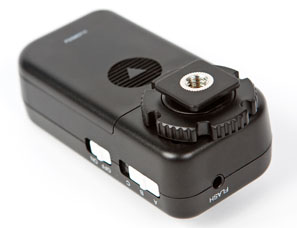
plastic shoe on the Odin receiver
|
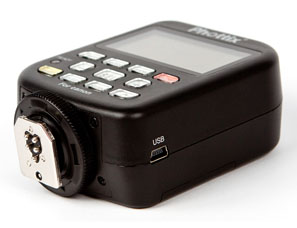
metal shoe on the TCU
|
Some comments on configuring flash parameters via the Odin TCU:
- the "OPT" button toggles between TTL/Mixed mode and Ratio mode
- TTL/Mixed mode allows each flash group (A / B / C) to be set to TTL mode (with up to 3 stops of +ve or -ve FEC applied), or set to manual mode (with flash output set to anything between 1/128 and full power in full-stop increments)
- Ratio mode allows a ratio to be specified between flash group A and B, from 1:8 to 8:1 (in half-stop increments), along with up to 3 stops of +ve or -ve FEC applied (in 1/3-stop increments)
- the "SEL" button toggles through each configurable option, with the "-" and "+" buttons used to change the value
- in TTL/Mixed mode, when setting a group (ie, hit the "SEL" button and a group flashes, indicating it is currently being configured), hitting the "MODE" button toggles between TTL, Manual and Off for that flash group
- the "ZOOM" button allows you to configure zoom settings for each of the flash groups
- when setting the zoom settings for a flash group, the "MODE" button toggles between TTL and Manual
- the "TEST" button does a test fire of all flashes, with group A triggered first, group B one second later, followed by group C
- holding down the "CLEAR" button will reset the all configuration values to defaults (except the selected channel)
- the "HI / >>>" button toggles between standard operation, high speed sync, and second curtain sync
- the modelling light causes all flashes attached to Odin receivers to fire continuously for 1 second (known as the modelling flash)
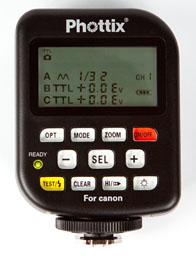
group A at 1/32 manual mode,
group B & C in TTL mode |
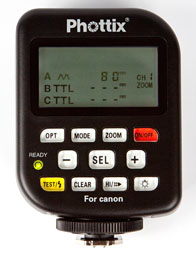
setting flash zoom,
group A set to 80mm, group B & C in TTL mode |
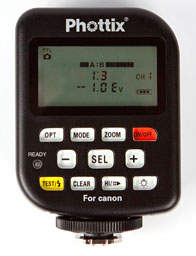
in ratio mode, A:B ratio at 1:3,
-1 stop FEC |
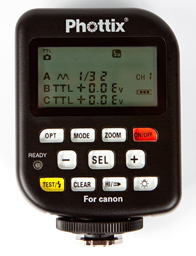
high-speed sync enabled
|
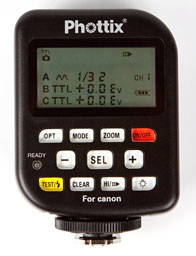
second curtain mode enabled
|
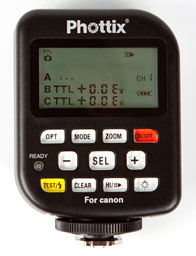
group A disabled
|
The photos below show the Odin TCU attached to the hot shoe of a Canon 50D, and an Odin receiver mounted on a light stand (using a spigot screwed into the 1/4" thread of the receiver), with a Canon 580EX II flash mounted on top of the receiver.
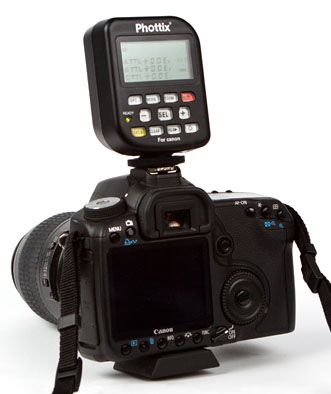
Phottix Odin TCU on a Canon 50D
|
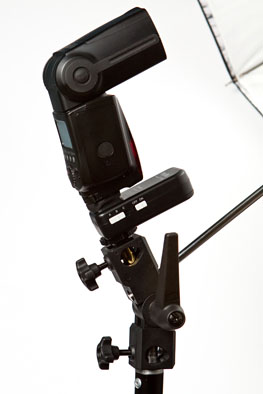
Odin receiver on a light stand
with a Canon 580EX II flash |
Note that with one or more flash groups in TTL mode, you can still configure up to two stops of flash exposure compensation (FEC) on your camera (depending on camera capabilities) to adjust the overall flash exposure.
I have been testing a pre-release version of the Odin with a Canon 50D camera, and few Canon flashes, namely a 430EX, 580EX and 580EX II.
I found the menus on the Odin TCU to be easy to navigate, and the operation of the TCU is quite intuitive. When I first received the Odin, I tried using it without reading the manual, to see how far I would get. I managed to figure out most of the functionality relatively easily, but had to resort to the manual to clarify some of the functionality, and figure out some of the less-obvious functionality.
In my testing, the Odin receivers triggered reliably every time, and I didn't encounter any mis-fires. Admittedly, my testing was relatively short-range, but I intend to do some longer-range testing in the near future.
Testing confirms that high-speed sync mode allows full flash sync at shutter speeds of upto 1/8000 seconds, and second curtain flash sync works as expected.
The accuracy of flash exposure in TTL mode will require some more testing, but initial tests indicate it seems to work quite well. I am intending to do some more testing to compare the Phottix Odin in TTL mode with a Canon ST-E2 and Canon 580EX II acting as master flash triggers, to get a better understanding of how effective the Odin's TTL mode works.
Apparently a firmware update for the Odin is available, but at the time of writing, I haven't been given access to it. This update resolves a few exposure-related issues, as well as adding compatibility with the Strato 4-in-1 and Strato II Multi receivers. I'm not sure compatibility will mean, but suspect it may allow the Odin TCU to trigger Strato and Strato II receivers (but without TTL support).
Update: I can confirm that the firmware update allows the Odin TCU to trigger Strato 4-in-1 and Strato II Multi receivers that are set to the same channel as the Odin TCU. Wireless TTL is not available for any flashes connected to Strato receivers. Any flashes connected to Strato receivers need to be set to manual mode, and the power output needs to be adjusted manually on those flashes.
Groups A, B and C on the Strato II Multi receivers correspond to the same groups on the Odin TCU, but any Strato II Multi receivers on group D will not be triggered.
When using ratio mode, the Odin TCU will not trigger any receivers in group C, but will only trigger groups A and B. This limitation also exists with the Canon ST-E2 in ratio mode, while a 580EX II as a master trigger will trigger group C when in ratio mode.
However, with the Odin's ability to have each group in with adjustable FEC, I don't think I'll be using ratio mode all that much anyway, so I don't consider this to be an issue for me.
A focus-assist light would have been useful in the Odin TCU for low light photography, but for various reasons the TCU doesn't have focus assist light.
Note that when focussing (with a half-press of the camera's shutter button), the focus assist lights on each flash will be triggered, so depending on the location and direction of the remote flashes, this may be sufficient in low light situations.
For flash groups in manual mode, the Odin TCU only allows the power output to be adjusted from full-power to 1/128 power in full stops (the 580EX / 580EX II allows manual power output to be adjusted in 1/3 stops from full-power to 1/128 power).
Update (21 August 2012): Phottix have released an updated firmware (version 1.20) for the Odin that provides support for 1/3 stops in manual mode.
Since then, I have also written about the new firmware, and provided some animated gifs showing the new 1/3 adjustment stops.
Phottix will need to provide updated firmware for the Odin to support newer camera models. This may mean that the Odin will not be compatible with newly released cameras, depending on how quickly Phottix provide updated firmware for new cameras.
I would like to see the exposure compensation range for each group in TTL mode increased from 3 stops (+ve and -ve) to maybe 6 stops each way. Hopefully Phottix can implement something like that in a firmware update for the Odin.
(Note that with one or more flash groups in TTL mode on the Odin, you can configure up to two stops of flash exposure compensation on the camera. This means you can effectively get upto 5 stops of FEC in one direction, up or down, by setting 2 stops on the camera, and 3 stops on the Odin.)
Here are some reasons:
- much better range than Canon ST-E2 or Canon 580EX as master flash trigger
- wireless ETTL support
- don't need line-of-sight between master and slave devices
- can adjust zoom of remote flashes from Odin's TCU
- even in manual mode, flash power output can be set from the Odin transmitter control unit
- high-speed sync up to 1/8000 seconds
- second curtain flash sync
- uses commonly available AA batteries
- compatibility with Phottix Strato 4-in-1 and Strato II Multi receivers
Definitely.
I regularly use a Canon ST-E2 or a Canon 580EX II as a master flash trigger to trigger multiple remote Canon flashes, and often get frustrated by the short range (especially outdoors), as well as the need for line-of-sight (or reflected line-of-sight) between the ST-E2 and the remote flashes.
While high-speed sync is possible with an ST-E2 or 580EX II, second curtain flash sync is not supported.
Conversely, if I use non-TTL flash triggers (to get around the range issues of the ST-E2 / 580EX), I have to set the flash power manually on each flash, and I lose high-speed sync and second curtain sync capability.
The Phottix Odin addresses all those shortcomings, and hence gives me a lot more flexibility and functionality for off-camera flash photography.
As of 20 September, the Phottix Odin for Canon is now available in Phottix's online store, in the following bundles:
- Odin TCU + Odin receiver for Canon (USD$350)
- Phottix Odin TCU
- Phottix Odin receiver
- PC sync cable with 3.5mm connector and PC sync connector
- PC sync cable with 2 x 3.5mm connector
- 3.5mm to 1/4" (6.3mm) adaptor
- lanyard for receiver
- USB cable
- 4 x AA batteries
- instructions CD
- additional Odin receiver for Canon (USD$145)
- Phottix Odin receiver
- PC sync cable with 3.5mm connector and PC sync connector
- PC sync cable with 2 x 3.5mm connector
- 3.5mm to 1/4" (6.3mm) adaptor
- lanyard for receiver
- USB cable
- 2 x AA batteries
- instructions CD

Update (18 June 2012): the Nikon version of the Phottix Odin is now available in Phottix's online store, in the following bundles:
- Odin TCU + Odin receiver for Nikon (USD$350)
- additional Odin receiver for Nikon (USD$145)
Update (17 September 2012): the Sony version of the Phottix Odin is now available:
- Odin TCU + Odin receiver for Sony (USD$350)
- additional Odin receiver for Sony (USD$145)
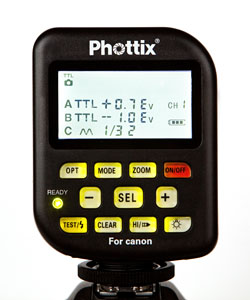
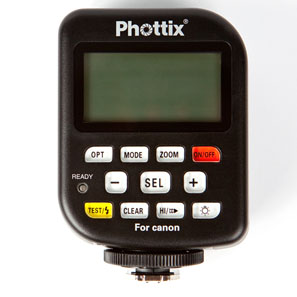
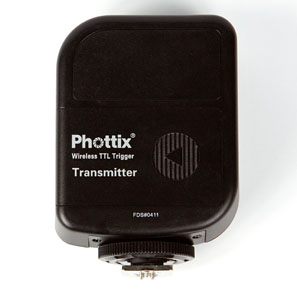
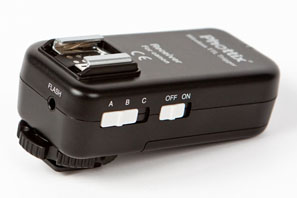
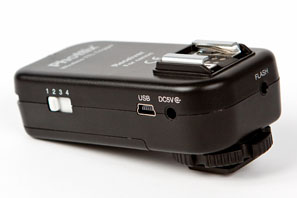
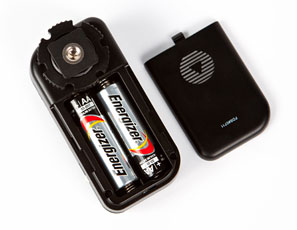
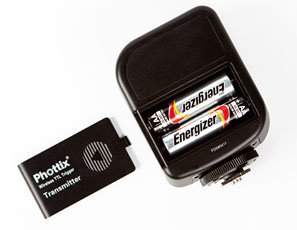
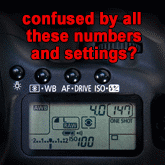


In other reviews and spec sheets it's indicated that there is an af assist light on the tcu. Could you just confirm that there is no af assist light on the final version Martin?